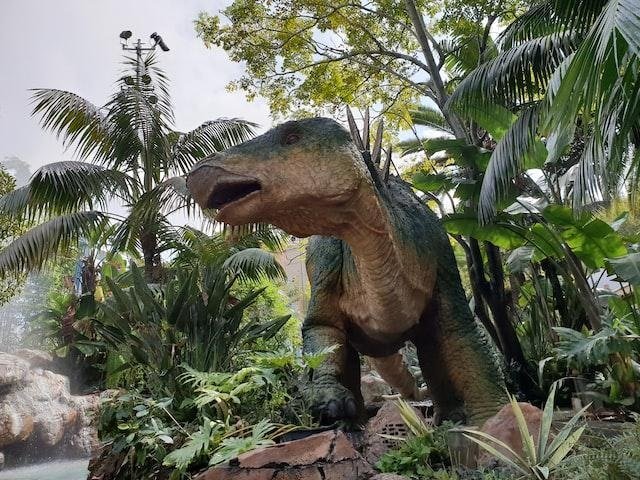If you’ve ever wondered what dinosaur has 500 teeth, you’re in for an exciting journey! The unique dinosaur known as the Nigersaurus is the answer to your curiosity. This remarkable herbivorous dinosaur roamed the Earth around 110 million years ago. With its astonishing number of teeth, the Nigersaurus exemplifies how different dinosaurs adapted to their environments, shedding light on what dinosaur has 500 teeth and its ecological significance.
Through its fascinating adaptations and feeding strategies, Nigersaurus offers incredible insights into prehistoric life. In this article, I’ll share five mind-blowing facts about this remarkable dinosaur, each accompanied by relevant information and context, exploring what dinosaur has 500 teeth in detail.
1. What Dinosaur Has 500 Teeth? Nigersaurus and Its Unique Dental Structure
Nigersaurus is often celebrated for its unique dental structure. With approximately 500 teeth, this dinosaur was specifically adapted to its herbivorous diet. Unlike most dinosaurs, which had robust teeth suited for tearing flesh, Nigersaurus had flat, leaf-like teeth perfect for grinding plants.
Key Features of Nigersaurus’s Teeth:
- Flat, Leaf-Shaped Design: Ideal for stripping leaves and vegetation.
- Rapid Tooth Replacement: Nigersaurus had the ability to replace lost teeth quickly, similar to some modern reptiles.
- Specialized for Grazing: This design made it efficient at feeding on low-growing vegetation, making it a perfect herbivore for its environment.
Nigersaurus’s unique dental characteristics allowed it to thrive in a lush habitat filled with various plants, which you can learn more about in sources like Paleontologist Paul Sereno’s work.
2. The Habitat of Nigersaurus: Where the Dinosaur with 500 Teeth Lived
During the Cretaceous period, Nigersaurus inhabited what is now Niger, West Africa. Contrary to the arid conditions we might associate with the Sahara Desert today, this area was once a vibrant floodplain with wide rivers and dense vegetation.
Features of Nigersaurus’s Habitat:
- Floodplains and Rivers: The environment supported a diverse range of life, including dinosaurs, crocodilians, and various reptiles.
- Rich Vegetation: Nigersaurus shared its habitat with lush plants like cycads, ferns, and conifers.
- Coexisting Dinosaurs: Alongside Nigersaurus lived other dinosaurs like Suchomimus, a fish-eating spinosaur, and Ouranosaurus, a large plant-eater.
This rich ecosystem provided ample food sources for Nigersaurus, making it a well-adapted dinosaur for its time.
3. The Size and Appearance of the Dinosaur with 500 Teeth
One of the fascinating aspects of Nigersaurus is its size and appearance. Despite having a large number of teeth, Nigersaurus was not particularly big compared to other sauropods. This unique dinosaur, often highlighted as what dinosaur has 500 teeth, was well-adapted to its herbivorous lifestyle.
Its numerous teeth allowed it to graze on low-lying vegetation efficiently, showcasing how evolutionary traits can vary even among large dinosaurs. Understanding the Nigersaurus and what dinosaur has 500 teeth provides valuable insights into the diversity and adaptability of prehistoric creatures.
Physical Characteristics:
- Length: Nigersaurus could grow up to 30 feet (9 meters) in length.
- Neck: Its long neck helped it reach high into trees, allowing it to graze on a variety of plant life.
- Lightweight Build: Nigersaurus had a relatively lightweight skeleton, making it more agile than some of its massive relatives.
Understanding the size and structure of Nigersaurus helps us appreciate its unique adaptations and the ecological niche it occupied.
4. Discovering Nigersaurus: The Journey to Uncovering the Dinosaur with 500 Teeth
Nigersaurus was first discovered in the 1990s by a team of paleontologists led by Paul Sereno. The discovery was significant because it revealed much about dinosaur diversity during the Cretaceous period.
Important Discoveries:
- Fossil Location: The fossils were found in the Gadoufaoua region of Niger, which is rich in dinosaur remains.
- Significance: The discovery helped scientists understand the diversity of herbivorous dinosaurs in Africa.
- Exhibits and Studies: The findings have led to various studies and exhibits, enhancing our knowledge of prehistoric life.
For more on the discovery of Nigersaurus and its significance in paleontology, check out Paul Sereno’s website on Nigersaurus.
5. Nigersaurus in Popular Culture: The Dinosaur with 500 Teeth in Media
Nigersaurus has also made its mark in popular culture, capturing the imagination of both scientists and the general public. Its unique features and striking appearance have led to various representations in media and educational materials.
Impact on Culture:
- Documentaries and Shows: Nigersaurus often appears in documentaries about dinosaurs, highlighting its unique characteristics.
- Educational Resources: The dinosaur is included in many educational programs aimed at teaching children about paleontology and prehistoric life.
- Fossil Exhibits: Nigersaurus fossils have been displayed in museums around the world, allowing visitors to learn about this fascinating creature.
Nigersaurus serves as an excellent example of how dinosaurs continue to capture our curiosity and enhance our understanding of Earth’s history.
Nigersaurus Facts
Nigersaurus, often recognized as the dinosaur with 500 teeth, was a unique herbivore from the Late Cretaceous period. This distinctive dinosaur had a broad, flat snout and specialized teeth designed for grazing on low-lying vegetation. With its impressive dental arrangement, the Nigersaurus exemplifies what dinosaur has 500 teeth, showcasing how it was well-adapted to its environment, allowing it to efficiently strip leaves and soft plants.
The discovery of fossils in Niger reveals crucial insights into its habitat and lifestyle, providing paleontologists with valuable information about this remarkable creature. Understanding the Nigersaurus and what dinosaur has 500 teeth expands our knowledge of dinosaur diversity and adaptation strategies in prehistoric ecosystems, highlighting its significance among herbivorous dinosaurs.
Dinosaur with Many Teeth
When we think about what dinosaur has 500 teeth, Nigersaurus stands out due to its remarkable dental structure. Unlike most dinosaurs, which had fewer, larger teeth, the Nigersaurus possessed a large number of small, pencil-like teeth that suited its herbivorous diet. These teeth were specifically designed for slicing through tough vegetation, making it easier for the dinosaur to consume a variety of plant material.
The unique adaptations of the Nigersaurus highlight the evolutionary pressures that shaped its feeding habits and provide a fascinating glimpse into the diversity of dinosaur life. This reinforces the notion that not all dinosaurs followed the traditional carnivorous or fewer-teeth herbivorous patterns.
Herbivorous Dinosaurs Characteristics
Herbivorous dinosaurs, including Nigersaurus, which is known as the dinosaur with 500 teeth, exhibited fascinating characteristics that allowed them to thrive in various environments. These dinosaurs often had specialized teeth and jaw structures that facilitated the consumption of tough, fibrous plant material. The Nigersaurus, often referenced when discussing what dinosaur has 500 teeth, exemplifies how evolution shaped its anatomy to adapt to a specific diet.
By understanding the characteristics of herbivorous dinosaurs like the Nigersaurus, which answers the question of what dinosaur has 500 teeth, researchers can better appreciate the ecological dynamics of the Mesozoic era and how these creatures interacted with their habitats. Such insights shed light on the complex relationships among plant life and the diverse range of herbivorous dinosaurs that roamed the Earth, reinforcing the importance of understanding what dinosaur has 500 teeth in the context of prehistoric ecosystems.
What Dinosaur Had 500 Teeth?
If you’re wondering what dinosaur had 500 teeth, look no further than Nigersaurus. This fascinating dinosaur was a part of the sauropod family and lived approximately 110 million years ago in what is now Niger. Its remarkable dental arrangement allowed it to effectively graze on vegetation near the ground, which made it unique among its contemporaries.
With a jaw designed for cropping low-growing plants, the Nigersaurus is a prime example of how adaptations in dental structure can influence a dinosaur’s feeding strategy. Learning about what dinosaur has 500 teeth not only provides insights into the life of Nigersaurus but also illustrates the evolutionary diversity of dinosaurs during the Cretaceous period.
Dinosaur Dental Adaptations
The dental adaptations of dinosaurs are varied and fascinating, especially when discussing what dinosaur has 500 teeth, such as the Nigersaurus. This dinosaur’s teeth were specifically adapted for grazing on plants, featuring a unique combination of numerous small teeth arranged in a way that maximized its ability to consume foliage efficiently. The Nigersaurus is often highlighted as a prime example of what dinosaur has 500 teeth, showcasing how these adaptations played a crucial role in its feeding strategy.
The Nigersaurus illustrates how evolutionary pressures can lead to specialized traits that enhance survival in particular niches. By examining the dental adaptations of the Nigersaurus, which exemplifies what dinosaur has 500 teeth, paleontologists gain insights into the feeding habits and ecological roles of herbivorous dinosaurs. This helps expand our understanding of the complexities of dinosaur evolution and the diverse diets that characterized different species, particularly when focusing on what dinosaur has 500 teeth and its significance in the Mesozoic ecosystem.
Unique Dinosaurs with Special Features
When we explore unique dinosaurs with special features, the Nigersaurus is notable for being the dinosaur with 500 teeth. This characteristic sets it apart from many other dinosaurs, as its teeth were specifically designed for its herbivorous diet. Often mentioned in discussions about what dinosaur has 500 teeth, the Nigersaurus had a broad skull and a distinctive jaw structure that allowed it to graze efficiently.
Its unique adaptations highlight the diversity of dinosaur life and how various species evolved specialized traits to thrive in their environments. Learning about such unique dinosaurs enriches our understanding of the evolutionary processes that shaped these ancient creatures and the ecosystems they inhabited, especially when considering what dinosaur has 500 teeth and its ecological significance.
FAQs About Nigersaurus
What type of dinosaur is Nigersaurus?
Nigersaurus is a sauropod dinosaur, specifically classified as a theropod due to its unique adaptations for herbivory.
Why does Nigersaurus have so many teeth?
Nigersaurus had around 500 teeth that were specifically adapted for grazing on low-lying vegetation. Its flat teeth allowed it to efficiently grind and consume plants.
When did Nigersaurus live?
Nigersaurus lived during the Cretaceous period, around 110 million years ago.
Where were Nigersaurus fossils found?
Fossils of Nigersaurus were discovered in Niger, West Africa, specifically in the Gadoufaoua region.
How big was Nigersaurus?
Nigersaurus could grow up to 30 feet (9 meters) in length, making it a relatively large but lightweight dinosaur.
Conclusion
In conclusion, what dinosaur has 500 teeth? The answer is Nigersaurus! With its unique adaptations, rich habitat, and fascinating discoveries, Nigersaurus is a testament to the diversity of life during the Cretaceous period. Its incredible features and contributions to our understanding of paleontology make it a standout dinosaur in the world of prehistoric creatures.
If you’re interested in exploring more about Nigersaurus and related topics, be sure to check out the Dolar canadiense a peso mexicano for insightful content. Understanding dinosaurs like Nigersaurus helps us appreciate the complex web of life that existed millions of years ago.
You May Also Like:




